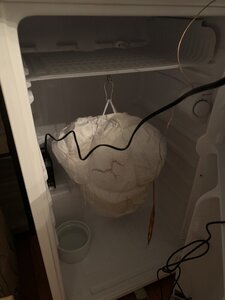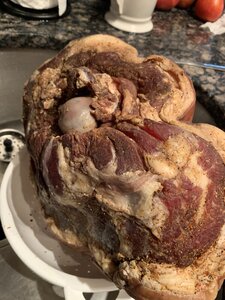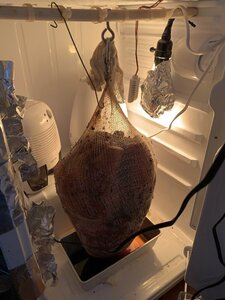Hello all,
New to the forum and curing meats! I've been dry curing my first country ham since the start of June. I used a standard recipe I found from a few sources (scaled down for the size of my ham): 3.2 lbs of kosher salt, 0.8 lbs of brown sugar, 0.16 lbs of black pepper, 0.16 lbs red pepper, 5 teaspoons of cure #2. This was for a ham that started at 23.28 lbs, so I actually over did the cure mixture a bit by weight. I packed the visible portions of meat with the cure mixture, making sure to stuff plenty into the hock end and around the pelvis joint. The ham cured for 77 days in a mini-fridge converted to keep temperature between 35-40 F. Then the ham went into an equalization phase in the same fridge, between 50-60 F. The humidity for both situations stayed around 50-65%. Currently, I'm aging the ham at a temp cycle of 75-95 with humidity around 55-65%. Weight loss after curing was 23.38 lbs down to about 20.9 lbs. Weight loss after equalization phase was 20.9 lbs don to 20.3 lbs. So at the start of aging, there has been about a 12.8% reduction in weight.
There are two questions that I have.
1.) The first is that the original ham socks I purchased were too small for the ham, so I needed a makeshift solution, which involved tying string around the middle of the ham for support, and then tying loops around that string that the ham could hang from. This created a bit of a pinch point in the middle of the ham and now it seems that the meat and skin might have separated during curing as it feels like there is a void under the skin in certain areas around the middle. I'm hoping this is just separation and not any other issue.
2.) Due to my mini-fridge having a freezer portion which gets much colder than the rest, the freezer would drip some water, especially during the equalization phase. It dripped on the ham a bit and caused some soft spots on the skin. There is currently still a soft spot on at least one location of the ham after the ham has been aging for about 10 days. Should this be cause for concern? There are no off odors or discoloration that I can see.
I've attached pictures of the process as well. The image of the ham hanging with butcher paper is the start of the cure process. You can see the string tied around the middle. The image of the ham hanging with the light and no butcher paper is the aging process. The image of the ham itself is right after salt equalization and before aging started. Any help/guidance would be greatly appreciated!
New to the forum and curing meats! I've been dry curing my first country ham since the start of June. I used a standard recipe I found from a few sources (scaled down for the size of my ham): 3.2 lbs of kosher salt, 0.8 lbs of brown sugar, 0.16 lbs of black pepper, 0.16 lbs red pepper, 5 teaspoons of cure #2. This was for a ham that started at 23.28 lbs, so I actually over did the cure mixture a bit by weight. I packed the visible portions of meat with the cure mixture, making sure to stuff plenty into the hock end and around the pelvis joint. The ham cured for 77 days in a mini-fridge converted to keep temperature between 35-40 F. Then the ham went into an equalization phase in the same fridge, between 50-60 F. The humidity for both situations stayed around 50-65%. Currently, I'm aging the ham at a temp cycle of 75-95 with humidity around 55-65%. Weight loss after curing was 23.38 lbs down to about 20.9 lbs. Weight loss after equalization phase was 20.9 lbs don to 20.3 lbs. So at the start of aging, there has been about a 12.8% reduction in weight.
There are two questions that I have.
1.) The first is that the original ham socks I purchased were too small for the ham, so I needed a makeshift solution, which involved tying string around the middle of the ham for support, and then tying loops around that string that the ham could hang from. This created a bit of a pinch point in the middle of the ham and now it seems that the meat and skin might have separated during curing as it feels like there is a void under the skin in certain areas around the middle. I'm hoping this is just separation and not any other issue.
2.) Due to my mini-fridge having a freezer portion which gets much colder than the rest, the freezer would drip some water, especially during the equalization phase. It dripped on the ham a bit and caused some soft spots on the skin. There is currently still a soft spot on at least one location of the ham after the ham has been aging for about 10 days. Should this be cause for concern? There are no off odors or discoloration that I can see.
I've attached pictures of the process as well. The image of the ham hanging with butcher paper is the start of the cure process. You can see the string tied around the middle. The image of the ham hanging with the light and no butcher paper is the aging process. The image of the ham itself is right after salt equalization and before aging started. Any help/guidance would be greatly appreciated!








